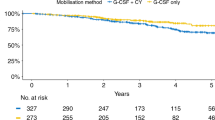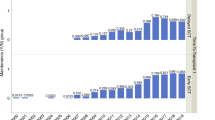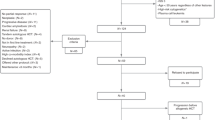Abstract
Two hundred and twenty-two myeloma patients autografted after 200 mg/m2melphalan were studied to examine the relationship between response to induction chemotherapy and outcome. Induction comprised cyclophosphamide, vincristine, doxorubicin and methylprednisolone (C-VAMP) every 3 weeks for one cycle beyond maximum response. 81% responded to C-VAMP (chemosensitive) with 40 complete (CR) and 139 partial (PR) remissions, and 43 did not respond (NR; <50% reduction in paraprotein; primary refractory). Overall, 130 patients (59%) attained or remained in CR post-transplant; including 40% of NR, 53% of PR, and 97% of CR after C-VAMP (P < 0.0001). Amongst these 130 patients, the 5-year OS was independent of response to C-VAMP (NR 79%, PR 74%, CR 60%; P = 0.69). Similarly, among the 69 patients in PR post-transplant, the 5-year OS was independent of response to C-VAMP. In Cox analysis, lack of response to C-VAMP did not affect outcome significantly. These data show that lack of response to induction therapy does not automatically predict poor long-term outcome in myeloma, since a substantial proportion of these patients attain CR after autograft and enjoy extended survival. Myeloma patients should not be disqualified from an autograft based upon lack of response to induction chemotherapy.
This is a preview of subscription content, access via your institution
Access options
Subscribe to this journal
Receive 12 print issues and online access
$259.00 per year
only $21.58 per issue
Buy this article
- Purchase on Springer Link
- Instant access to full article PDF
Prices may be subject to local taxes which are calculated during checkout







Similar content being viewed by others
References
McElwain TJ, Powles RL . High-dose intravenous melphalan for plasma-cell leukaemia and myeloma Lancet 1983 2: 822 824
Barlogie B, Hall R, Zander A et al. High-dose melphalan with autologous bone marrow transplantation for multiple myeloma Blood 1986 67: 1298 1301
Barlogie B, Hall R, Zander A et al. High-dose melphalan with autologous bone marrow transplantation for multiple myeloma Blood 1986 67: 1298 1301
Powles R, Raje N, Milan S et al. Outcome assessment of a population-based group of 195 unselected myeloma patients under 70 years of age offered intensive treatment BoneMarrow Transplant 1997 20: 435 443
Attal M, Harousseau JL, Stoppa AM et al. A prospective, randomized trial of autologous bone marrow transplantation and chemotherapy in multiple myeloma. Intergroupe Français du Myelome New Engl J Med 1996 335: 91 97
Mehta J, Powles RL . Autologous blood and marrow transplantation. In: Whittaker JA, Holmes JA (eds) Leukaemia and Associated Diseases Blackwell Science: Oxford 1998 455 481
Barlogie B, Jagannath S, Desikan KR et al. Total therapy with tandem transplants for newly diagnosed multiple myeloma Blood 1999 93: 55 65
Dimopoulos MA, Hester J, Huh Y et al. Intensive chemotherapy with blood progenitor transplantation for primary resistant multiple myeloma Br J Haematol 1994 87: 730 734
Alexanian R, Dimopoulos MA, Hester J et al. Early myeloablative therapy for multiple myeloma Blood 1994 84: 4278 4282
Medicare Coverage Policy, Decisions. Autologous stem cell transplantation (AuSCT) for multiple myeloma (#CAG-00011B)
Powles R, Milan S, Horton C et al. The Royal Marsden Hospital leukemia-myeloma database: an ‘operations research’ resource for assessing clinical outcomes and planning new drug trials Blood 2001 98: (Suppl. 1) Abstr. 1788
Gore ME, Selby PJ, Viner C et al. Intensive treatment of multiple myeloma and criteria for complete remission Lancet 1989 2: 879 882
Powles R, Raje N, Horton C et al. Comparison of interferon tolerance after autologous bone marrow or peripheral blood stem cell transplants for myeloma patients who have responded to induction therapy Leuk Lymphoma 1996 21: 421 427
Cunningham D, Powles R, Malpas J et al. A randomized trial of maintenance interferon following high-dose chemotherapy in multiple myeloma: long-term follow-up results Br J Haematol 1998 102: 495 502
Vesole DH, Crowley JJ, Catchatourian R et al. High-dose melphalan with autotransplantation for refractory multiple myeloma: results of a Southwest Oncology Group phase II trial J Clin Oncol 1999 17: 2173 2179
Rajkumar SV, Fonseca R, Lacy MQ et al. Autologous stem cell transplantation for relapsed and primary refractory myeloma Bone Marrow Transplant 1999 23: 1267 1272
Singhal S, Mehta J, Desikan R et al. Antitumor activity of thalidomide in refractory multiple myeloma New Engl J Med 1999 341: 1565 1571
Singhal S, Mehta J . Thalidomide in cancer – potential uses and limitations BioDrugs 2001 15: 163 172
Richardson PG, Berenson J, Irwin D et al. Phase II study of PS-341, a novel proteasome inhibitor, alone or in combination with dexamethasone in patients with multiple myeloma who have relapsed following front-line therapy and are refractory to their most recent therapy Blood 2001 98: (Suppl. 1) Abstr. 3223
Vacca A, Singhal S, Ribatti D, Dammacco F . Angiogenesis in plasma cell disorders. In: Mehta J, Singhal S (eds) Myeloma Martin Dunitz: London 2002 119 135
Vesole DH, Barlogie B, Jagannath S et al. High-dose therapy for refractory multiple myeloma: improved prognosis with better supportive care and double transplants Blood 1994 84: 950 956
Björkstrand B, Goldstone AH, Ljungman P et al. Prognostic factors in autologous stem cell transplantation for multiple myeloma: an EBMT Registry Study. European Group for Bone Marrow Transplantation Leuk Lymphoma 1994 15: 265 272
Desikan KR, Tricot G, Dhodapkar M et al. Melphalan plus total body irradiation (MEL-TBI) or cyclophosphamide (MEL-CY) as a conditioning regimen with second autotransplant in responding patients with myeloma is inferior compared to historical controls receiving tandem transplants with melphalan alone Bone Marrow Transplant 2000 25: 483 487
Sirohi B, Powles R, Mehta J et al. Complete remission rate and outcome after intensive treatment of 177 patients under 75 years of age with IgG myeloma defining a circumscribed disease entity with a new staging system Br J Haematol 1999 107: 656 666
Sirohi B, Powles R, Sumpter K et al. A comparison of kinetics of paraprotein clearance: rapid decline of paraprotein after high-dose melphalan (HDM) versus infusional chemotherapy (IC) in previously untreated patients with IgG multiple myeloma Bone Marrow Transplant 2000 25: (Suppl. 1) S218
Powles R, Sirohi B, Kulkarni S et al. Can high-dose melphalan with autotransplantation be used as primary therapy for multiple myeloma as the first step towards an ‘operational cure’? Bone Marrow Transplant (submitted)
Powles R, Sirohi B, Kulkarni S et al. Acute lymphoblastic leukaemia-type intensive chemotherapy to eliminate minimal residual disease after high-dose melphalan and autologous transplantation in multiple myeloma – a phase I/II feasibility and tolerance study of 17 patients Bone Marrow Transplant 2000 25: 949 956
Powles R, Sirohi B, Treleaven J et al. Continued first complete remission in multiple myeloma for over 10 years: a series of ‘operationally cured’ patients Blood 2000 96: (Suppl. 1) 515a
Acknowledgements
This study was supported by the Bud Flanagan Leukaemia Fund, the David Adams Leukaemia Fund, the Cancer Research Campaign and the Institute of Cancer Research.
Author information
Authors and Affiliations
Rights and permissions
About this article
Cite this article
Singhal, S., Powles, R., Sirohi, B. et al. Response to induction chemotherapy is not essential to obtain survival benefit from high-dose melphalan and autotransplantation in myeloma. Bone Marrow Transplant 30, 673–679 (2002). https://doi.org/10.1038/sj.bmt.1703717
Received:
Accepted:
Published:
Issue Date:
DOI: https://doi.org/10.1038/sj.bmt.1703717
Keywords
This article is cited by
-
Should I stay or should I go (to transplant)? Managing insufficient responses to induction in multiple myeloma
Blood Cancer Journal (2023)
-
Impact of Pre-transplant and Post-transplant Remission Status of Patients on Survival in Newly Diagnosed Multiple Myeloma
Indian Journal of Hematology and Blood Transfusion (2019)
-
Utilization of hematopoietic stem cell transplantation for the treatment of multiple myeloma: a Mayo Stratification of Myeloma and Risk-Adapted Therapy (mSMART) consensus statement
Bone Marrow Transplantation (2019)
-
Risk stratification in myeloma by detection of circulating plasma cells prior to autologous stem cell transplantation in the novel agent era
Blood Cancer Journal (2016)
-
Association of response endpoints with survival outcomes in multiple myeloma
Leukemia (2014)



